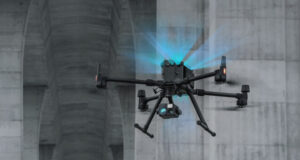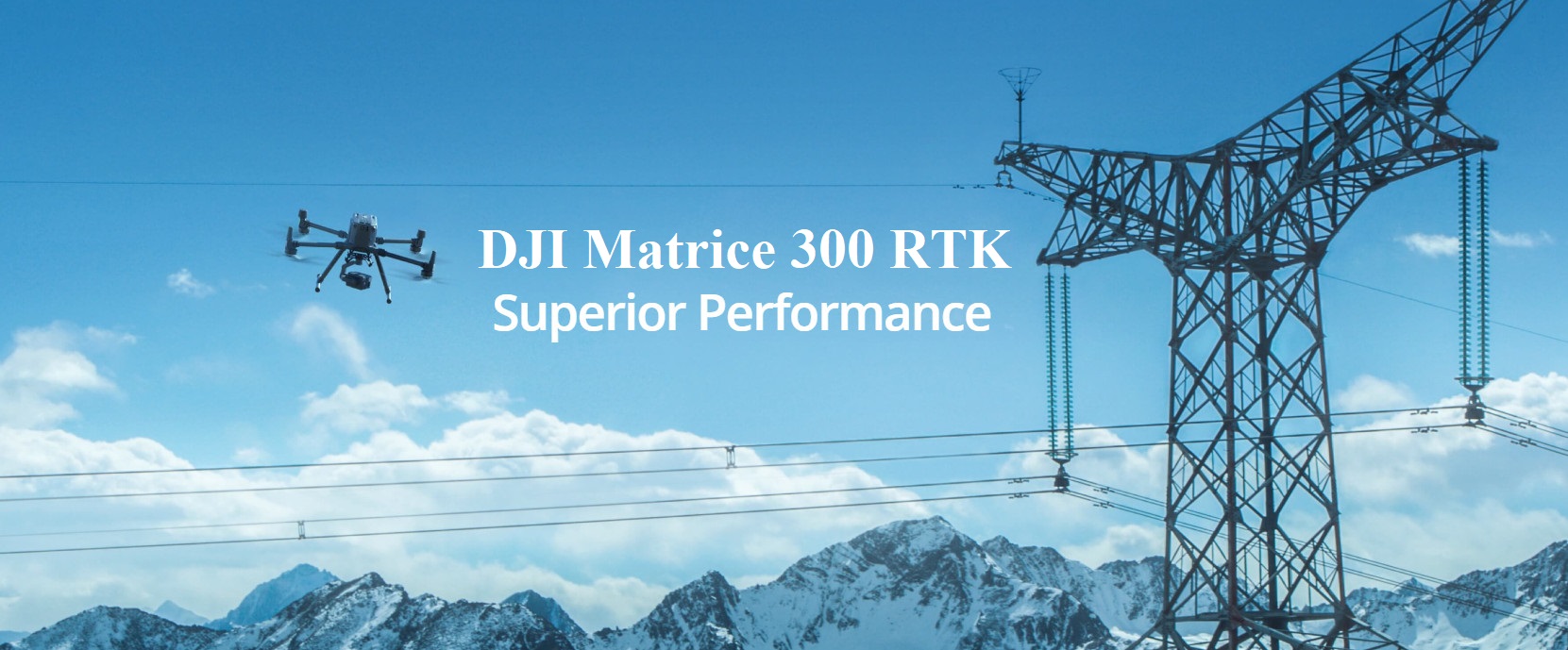In 2020, DJI unveiled the DJI Matrice 300 RTK, the latest product in their Matrice drone series, designed with inspiration from modern aviation systems. Designed for industrial and commercial use, the Matrice 300 RTK is packed with advanced AI capabilities and innovative features, making it ideal for a wide range of applications. Compared to other commercial drones, the DJI Matrice RTK 300 excels at performing smarter and more efficient inspections.
The DJI Matrice 300 RTK features extended flight range and time, a flexible remote controller setup, and cutting-edge AI features to simplify complex missions. To highlight its innovations, here is a look at the most exciting features of the Matrice 300 RTK:

Compatible Payloads of DJI Matrice 300 RTK
The Matrice 300 RTK stands out in drone technology, supporting multiple payloads including the Zenmuse H20 (visual) and H20T (thermal) cameras. Every mission is unique, whether it’s reconnaissance, surveillance or firefighting, and the payload must adapt to the task. The Matrice 300 can carry up to three payloads simultaneously, with a maximum capacity of 2.7 kg, providing unmatched versatility for a variety of tasks.
Flight Time
A major challenge in drone surveying or mapping is the need to stop and replace batteries in the middle of a mission. The Matrice 300 RTK has a maximum flight time of 55 minutes, allowing you to complete your mission without interruption. This extended flight time is particularly important for large-scale operations, ensuring the drone is still operational when it’s needed most.
Inspection Features
When paired with the Zenmuse H20 Series, the Matrice 300 RTK provides a powerful and intelligent solution for a variety of applications.
- Smart Inspection: This feature reduces operational limitations for pilots, making routine data collection tasks such as power line, oil rig and railway inspections more accessible. Experienced pilots can initially handle complex inspections, while new pilots can perform the same inspection later using Smart Inspection’s automated features, ensuring safety and ease.
- Live Mission Recording: This feature improves Waypoint GPS navigation by allowing users to record all the details of a flight mission, including aircraft movements, gimbal orientation, photo settings, and zoom level. These recordings can be used to create sample mission files for future automated inspections, streamlining complex projects.
- AI Spot Check: Drone inspections can be affected by slight changes in the camera view due to unstable wind conditions or gimbal movement, especially at higher zoom levels. AI Spot Check addresses this problem by allowing objects of interest to be marked during a demo flight. Onboard AI algorithms then replicate the target’s position, angle, framing, and orientation for future missions, ensuring consistent data capture.
- Waypoints 2.0: The new Waypoints 2.0 mission planning system allows users to create up to 65,535 waypoints and set multiple actions for one or more payloads, including third-party payloads. This makes flight path planning more efficient and flexible, especially for difficult inspections.
- Pinpoint: With a quick tap, users can mark an object in the camera or map view, and advanced sensor fusion algorithms will calculate its coordinates, displaying them as an AR icon in all camera views.
- Smart Track: This feature allows you to identify and track moving objects such as people, cars, and boats, with auto-zoom capabilities to keep them in focus.
Advanced Dual Control Modes
The M300 RTK’s dual pilot control protocols enhance mission safety and flexibility. Both pilots have equal access to flight control priority, indicated by icons on the DJI Smart Controller Enterprise. This allows for seamless switching between controlling the drone and its gimbal, enabling missions beyond visual line-of-sight (BVLOS). Missions can begin at one pilot’s location and end at another’s location, maintaining visual line-of-sight throughout.
OcuSync Enterprise
The Matrice 300 RTK features DJI’s latest transmission system, OcuSync Enterprise, which supports triple 1080p 30FPS downlink transmissions at distances up to 15km. This provides pilots with the most responsive and long-range connection to their drone and payload, allowing them to access mission-critical information and easily transition between displays using the Smart Controller.
IP45 rating
Beyond collisions, drones are vulnerable to environmental hazards such as dust and water. The Matrice 300 RTK’s IP45 ingress protection ensures dust and water resistance, allowing you to conduct missions in adverse weather conditions without worry.
This comprehensive set of features makes the DJI Matrice 300 RTK a powerful tool for industrial and commercial applications, delivering unparalleled flexibility, reliability, and intelligence.

Applications of DJI Matrice 300 RTK
- Firefighting:- Fight fires and save lives without endangering personnel.
- Search & Rescue:- Act quickly to locate missing people and better plan rescue missions.
- Law Enforcement:- Quickly assess a situation and plan accordingly while improving officer and bystander safety.
- Powerline Inspection:- Easily visualize extensive power line networks in remote areas.
- Oil & Gas:- Conduct inspections of pipelines, well sites, and more while keeping workers away from risky areas.
- Geomatics:- Digitize surveying workflows and improve efficiency in data collection and analysis.
DJI Matrice 300 RTK Specifications
Here are some key specifications of the DJI Matrice 300 RTK:
- Aircraft:
- Dimensions (unfolded): 810 x 670 x 430 mm
- Dimensions (folded): 430 x 420 x 430 mm
- Weight (with two TB60 batteries): Approximately 3.6 kg
- Max Takeoff Weight: 9 kg
- Maximum Flight Time: Up to 55 minutes (without payload)
- Maximum Flight Speed: 23 m/s (51.4 mph)
- Maximum Service Ceiling Above Sea Level: 7,000 meters (22,966 feet)
- Operating Temperature: -20°C to 50°C
- Propulsion System:
- Motor: DJI 2208 80W
- Propeller: 15-inch foldable propellers
- Battery:
- Battery Type: TB60 Intelligent Flight Battery
- Capacity: 5935 mAh
- Voltage: 52.8 V
- Battery Weight: 1.35 kg
- Flight Control System:
- Flight Controller: DJI A3 Pro
- GNSS: GPS+GLONASS+BeiDou+Galileo
- Precision: Horizontal ±1.5 m, Vertical ±0.5 m
- Payload Capacity:
- Maximum Payload Capacity: 2.7 kg (6 pounds)
- Transmission System:
- Transmission System: OcuSync Enterprise
- Operating Frequency: 2.4000-2.4835 GHz, 5.725-5.850 GHz
- Max Transmission Range (unobstructed, free of interference):
- FCC: 15 km (9.3 miles)
- CE: 8 km (5 miles)
- SRRC: 8 km (5 miles)
- MIC: 8 km (5 miles)
- Obstacle Sensing System:
- Forward Sensing Range: 0.7 to 40 meters
- Upward Sensing Range: 0.6 to 30 meters
- Downward Sensing Range: 0.6 to 30 meters
- Rear Sensing Range: 0.6 to 30 meters
- Sides Sensing Range: 0.6 to 30 meters
- Camera Compatibility:
- Compatible Cameras: Zenmuse H20 series, Zenmuse H20T, Zenmuse XT2, Zenmuse Z30, and third-party cameras that support DJI payload SDK.
These specifications provide a general overview of the DJI Matrice 300 RTK’s capabilities. For more detailed and comprehensive information, including specific payload options and accessories, I recommend referring to the official DJI website or product documentation.
Frequently ask question about DJI matrice 300 RTK
What is the DJI Matrice 300 RTK used for?
The drone DJI Matrice 300 RTK has various applications like reconnaissance, surveillance, or firefighting and carry multiple payload if need a sophisticated mission.
Does DJI Matrice 300 RTK come with a camera?
No,
The DJI Matrice 300 RTK does not come with a built-in camera. DJI offers a range of compatible cameras that can be used with the Matrice 300 RTK, such as the Zenmuse H20 series, Zenmuse H20T, Zenmuse XT2, Zenmuse Z30, and third-party cameras that support DJI’s payload SDK (Software Development Kit). These cameras include features such as high-resolution imaging, thermal imaging, zoom capabilities, and other specialized functionalities
How much does a DJI matrice cost?
The DJI Company provides Matrice 300 RTK in $10,000 with some accessories like remote controller, two batteries, a battery station, and a storage case. With thermal vision drone package start at $14,000
How much can a Matrice 300 RTK carry?
The maximum capacity of Matrice 300 RTK Payload Configurations up to 6 lbs (2.7 kg).
Do I need a base station for my RTK drone?
Yes,
for precise positioning and real-time kinematic (RTK) functionality, you typically need a base station when using an RTK drone like the DJI Matrice 300 RTK. A base station is an essential component of the RTK system and is used to provide reference data for the drone’s onboard RTK receiver.
The base station receives signals from Global Navigation Satellite Systems (GNSS) such as GPS, GLONASS, or BeiDou, and calculates its precise location. It then transmits this accurate reference position information to the RTK-enabled drone in real-time. The drone’s RTK receiver uses this reference data to correct its own positioning, resulting in centimeter-level accuracy.
How far can DJI Matrice 300 RTK fly?
15 km away
The DJI Matrice 300 RTK has an impressive flight range that allows it to cover considerable distances. The Matrice 300 RTK has a maximum flight range of up to 15 kilometers (9.3 miles) when operating in ideal conditions.
Also read:- DJI mavic 3 pro

